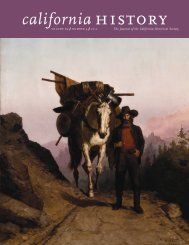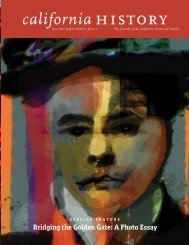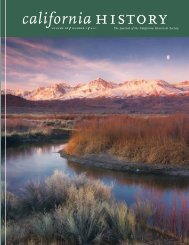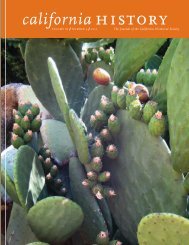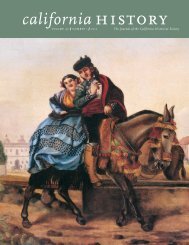People’s Park:Birth and SurvivalBy Jon David CashPeople’s Park marked the beginning of something new. For alienated youngpeople, it demonstrated that they could act creatively and together to buildan environment uniquely theirs where they could celebrate the rituals of anew culture. Although they lost the park, most felt that it was only a battlein a war that they would win someday.—Sim Van der Ryn, University of <strong>California</strong>, 1970 1Prologue: The University,the Community, and Lot 1875-2The University of <strong>California</strong>’s interest in thelot now famed as People’s Park dates backto 1952, when the Board of Regents deviseda long-range development plan designatingmuch of the south campus area of Berkeleyfor potential university growth. A 1956 revisionof the plan assured that it would be conducted insuch a way as to provide “a well-rounded life forstudents.” According to a 2007 study, universityadministrators embraced a policy of acquiring“large lots of land outside the campus” to develop“high-rise, modernist residential halls, administrativebuildings, and specialized sports fields.” 2Even in the relatively apolitical 1950s, it wasapparent that this area was closely intertwinedwith a developing youth culture. Berkeley’sTelegraph Avenue, consisting primarily of olderhouses often rented as low-income residences bystudents and the bookstores and coffeehousesthey frequented, was of particular significance.Running through the city’s business district andterminating at the campus gates, it had acquiredan anti-authoritarian reputation. As the journalistRobert Scheer noted: “Telegraph Avenue came torival San Francisco’s North Beach as the vital centerof the Beat Generation, with Allen Ginsbergand Gregory Corso denouncing the sterile socialorder and calling for liberation from their forumat Robbie’s Chinese-American restaurant.” 3In 1967, when the mass media coined the term“hippie” and publicized a “summer of love” inthe countercultural haven of San Francisco’sHaight-Ashbury district, thousands of teenagerunaways flooded into the Haight, causing massiveovercrowding. Older nonconformist residentsreacted with a mass exodus, gravitating tothe Telegraph Avenue area, whose environmentrecalled an earlier Haight-Ashbury. There theymingled with anti–Vietnam War activists. Alongthe local shops and stores, hippies and radicalsshared their mutual disdain for a war thatinvolved over a half million servicemen and costover 50,000 American lives. This informal alli-<strong>California</strong> History • volume 88 number 1 2010
ance soon would join forces in opposition to theuniversity’s expansion into their south campusneighborhood. 4From the development plan’s inception, campusadministrators had crept along with its implementation.In 1956, the Regents authorized aland-acquisition program, including Lot 1875-2,the three-acre parcel on which People’s Parkwould be constructed (a block east of TelegraphAvenue and bordered on the south by DwightWay, on the north by Haste Street, and on theeast by Bowditch Street). The Regents, however,did not allocate the funding necessary to purchasethe property. Finally, in June 1967, UCBerkeley Chancellor Roger W. Heyns and Vice-Chancellor Earl Cheit persuaded the Regents toallocate $1.3 million to acquire the lot. Justifyingthe urgency of the transaction, they cited a“desperate need” for the construction of a soccerfield. This “desperate need” apparently was afleeting one, since Heyns further conjecturedthat the site ultimately would be used for studenthousing by the late 1970s. 5In reality, the campus did not possess a dire needfor either student housing or a soccer field. Asdormitory usage declined from 5,064 students in1964 to 2,898 students in 1970, space in previouslyconstructed dormitories remained unused.The Regents, noting that the state barely brokeThe 1969 People’s Park controversy began with its creationin April and ended a month later in bloodshed. A source ofconflict since its founding, the park to some is a symbol ofcivil disobedience, memorializing the city’s role in the antiwarand free speech movements of the 1960s and the ecologymovement of the 1970s. Others consider it “a creativeecological endeavor,” as park founder Wendy Schlesingerdescribed: “At the Park, hippies and business people workedtogether, old and young, black, white, Asian, Latinos, menand women and children, all smiling, all unified in theirquest to create beauty out of waste and to ‘get a blister’ fora good cause.”Courtesy of Terri Compost; photograph by B. N. Duncan9
- Page 3: california historyvolume 88 number
- Page 6 and 7: c o l l e c t i o n sAdmission tick
- Page 8 and 9: c o l l e c t i o n sBusiness cards
- Page 12 and 13: even on existing dorms due to the h
- Page 14 and 15: The attraction, however, was fleeti
- Page 16 and 17: Bay Area—North Beach and Haight-A
- Page 18 and 19: A hundred students, activists, and
- Page 20 and 21: are building a park on the land. We
- Page 22 and 23: and illegal drug use in the park. T
- Page 24: without even allowing Siegel to con
- Page 27 and 28: As Bloody Thursday came to a close,
- Page 29 and 30: this state.” On June 20, Reagan t
- Page 31 and 32: Denovo, her autopsy revealed a down
- Page 33 and 34: ation and encouragement, and shed n
- Page 35 and 36: the guardians of her children. The
- Page 37 and 38: mitted to visit Caroline in her new
- Page 39 and 40: Sojourner Truth gave what famously
- Page 41 and 42: After emancipation, she helped to o
- Page 43 and 44: This 1885 view captures the sparsel
- Page 45 and 46: But Caroline thought it imprudent t
- Page 47 and 48: The “Mother of Clubs”In Boston,
- Page 49 and 50: Caroline attended the September 189
- Page 51 and 52: ments, Seymour and Sibley earned pe
- Page 53 and 54: In this photograph, San Francisco s
- Page 55 and 56: n o t e s12People’s Park: Birth a
- Page 57 and 58: 1969; McGill, The Year of the Monke
- Page 59 and 60: that “thousands of the brightest
- Page 61 and 62:
For Both Cross andFlag: Catholic Ac
- Page 63 and 64:
d o n o r sThe California Historica
- Page 65 and 66:
In Kind DonationsSandy Alderson, Sa
- Page 67:
Membership BenefitsJoin tHeCaliforn



